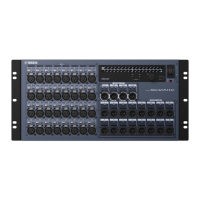What causes the head amp to be uncontrollable on Yamaha Rio3224-D2?
- CCarolyn AlexanderSep 1, 2025
If the head amp cannot be controlled on your Yamaha Recording Equipment, ensure that the Rio has been mounted on the RACK of the Rio2-native device.

What causes the head amp to be uncontrollable on Yamaha Rio3224-D2?
If the head amp cannot be controlled on your Yamaha Recording Equipment, ensure that the Rio has been mounted on the RACK of the Rio2-native device.
How to fix Rio when it cannot be found in Dante Controller for Yamaha Rio3224-D2 Recording Equipment?
If the Rio cannot be found in Dante Controller with your Yamaha Recording Equipment, initialize the Rio.
Why doesn't adjusting head amp gain change audio level on Yamaha Recording Equipment?
If adjusting the internal head amp gain on your Yamaha Recording Equipment doesn't change the audio level, it might be because the Gain Compensation function is turned on. If you are not using the Gain Compensation function, turn it off.
What to do if Rio cannot be found in R Remote for Yamaha Recording Equipment?
If the Rio is not found in R Remote for your Yamaha Recording Equipment, verify that the UNIT ID setting does not conflict with another R series unit by setting each UNIT ID uniquely. Also, check the IP address setting and ensure the network is correctly connected, verifying they are set to the same subnet. If the SECONDARY PORT parameter is set to REDUNDANT, ensure the unit is connected to the [PRIMARY] port.
Why is the input level too low on my Yamaha Recording Equipment?
If the input level on your Yamaha Recording Equipment is too low, and you're using a condenser microphone, turn the [+48V MASTER] switch ON. Also, ensure that the internal head amplifier gain is set to an appropriate level.
What to do if Yamaha Recording Equipment is not receiving an input signal?
If your Yamaha Recording Equipment isn't receiving an input signal, check these items: * Ensure the input cables are correctly connected. * Verify the source device is sending a signal and that the SIG indicators on the appropriate channels are lit. * Confirm the internal head amplifier gain is set correctly. * If the SETUP menu’s START UP MODE is set to REFRESH, ensure the Rio2-native device has started.
How to fix Yamaha Rio3224-D2 Recording Equipment when the power won’t turn on?
If your Yamaha Recording Equipment isn't turning on, first, ensure the power cable is properly connected. Also, check that the [POWER] switch is turned ON. If it still doesn't power on after these steps, contact your Yamaha dealer.
| Audio input | 32 |
|---|---|
| Form factor | Rackmounted |
| Product color | Black |
| AC input voltage | 100 - 240 V |
| AC input frequency | 50 - 60 Hz |
| Power consumption (typical) | 120 W |
| Manual | Yes |
| D/A dynamic range | 112 dB |
| D/A frequency range | 20 - 20000 Hz |
| Audio A/D Converter (ADC) | - |
| Depth | 368 mm |
|---|---|
| Width | 480 mm |
| Height | 220 mm |
| Weight | 13500 g |
Provides essential safety instructions for operation, installation, and maintenance to prevent injury or damage.
Covers safe handling of power cords, plugs, grounding, and electrical hazards.
Guidelines for safe and effective rack mounting to ensure proper ventilation and prevent overheating.
Describes analog input connectors, +48V phantom power, and signal/peak level indicators.
Explains the power switch operation and the [+48V MASTER] switch for phantom power.
Describes the PRIMARY/SECONDARY etherCON ports, link/activity, and gigabit indicators.
Details how to set input gain, compensation gain, and view port status in the GAIN menu.
Describes how to turn the high-pass filter ON or OFF for input ports.
Details how to adjust the HPF cutoff frequency for input ports in the HPF F menu.
Details how to set parameter values using the encoder and the confirmation process.
Describes controlling head amplifiers remotely from Rio2-native devices or R Remote software.
Lists head amplifier parameters like +48V, HA GAIN, HPF, and METER that can be monitored and controlled.
Provides a table of common symptoms, their causes, and possible solutions for unit malfunctions.
Lists and explains system, Dante module, MAC address, fan, and memory errors and their solutions.
Details firmware mismatches, power supply failures, network link issues, and Dante connection warnings.
Explains information, confirmation, and system messages, including factory initialization and panel lock status.
Details system error codes like VERSION MISMATCH, AUDIO RESOURCE OVERFLOW, and POWER SUPPLY FAILED.
Explains normal operation, synchronization status, and messages related to word clock and Dante connections.
Details input/output impedance, gain, level ranges, and connector types for analog signals.